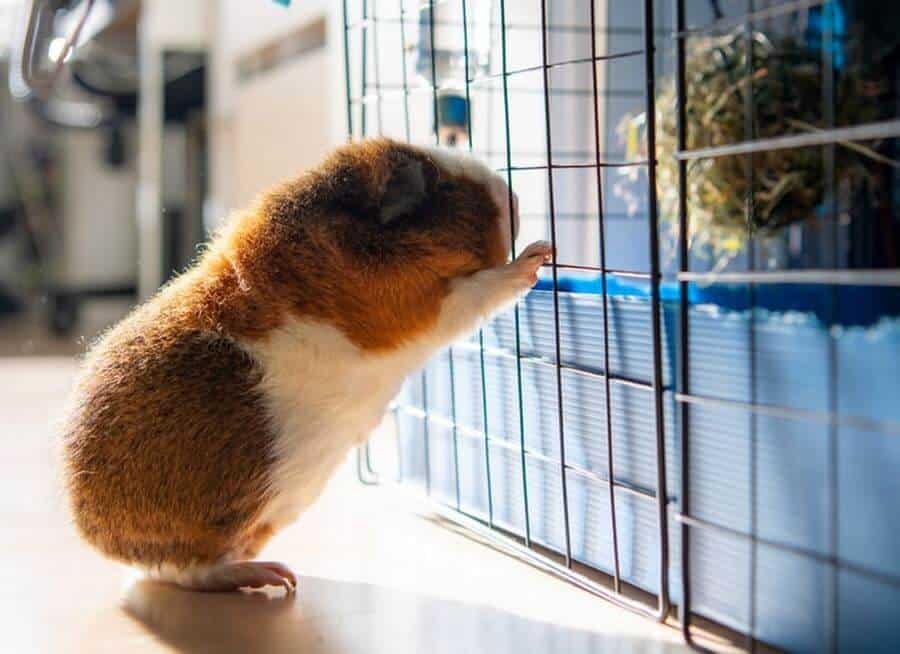Getting a guinea pig for a pet is such an exciting experience! These adorable rodents are quirky pets that are really fun to engage with. Guinea pigs have a reputation of being boring, however, this isn’t true. They have interests just like any other pet.
The best way to help guinea pigs live an enriching life is by providing them with plenty of things to interact with. The first step in doing this is by having a proper cage setup.
While they shouldn’t be in their cages all of the time, guinea pigs are still spending a lot of time in their cages. This is why it is critical to ensure they have everything they need. A guinea pig with a properly setup cage is a happy guinea pig!
Setting up a guinea pig cage isn’t difficult. In fact, it can be a lot of fun, especially when you see how happy it will make your piggie! All guinea pig cages need some pretty basic items. Additionally, there are supplemental items that can be added to enrich their cage environment.
Always start the very basic items, as piggies need those things to survive, and then add additional items that are suited to your piggie’s interest. Every guinea is different and you will find that each one has items that it likes to interact with. Below are the key important items for piggies and a list of supplemental items to consider!
Basic Items For Guinea Pig Cages
1. Guinea Pig Food Dish For Enriched Nourishment
A food dish is an important part of a guinea pig cage. Obviously, it provides a place to store the food a piggie will eat. It should be something ceramic so that it has a heavy bottom. This lessens the chances of them tipping the bowl over and making a mess. There are even tip-proof bowls on the market for small animals.
Food bowls are necessary to contain pellets or pieces of veggies that have been cut up for the piggies.

2. Water bottle To Keep A Guinea Pig Well Hydrated
Every guinea pig cage should have a water bottle. There are special bottles that they use that have long nozzles attached to a reservoir that holds water. These nozzles are generally metal and have small metal balls on the end.
Guinea pigs (along with rabbits, rats, or hamsters!) use their tongues to roll the bottle to get the water. This is the easiest way for them to drink water. Water dishes aren’t suitable as guinea pigs do not drink from as easily as they do the water bottles.
These special water bottles are affixed to the side of the cage by a wire. They don’t take up too much space and stay securely along the side of the cage. They should be refilled every day or every other day. This ensures that your guinea pig has fresh water most of the time!
3. A Guinea Pig Hide-Away For Comfort And Safety
While guinea pigs are naturally curious animals they are also leary of their surroundings. They are prey animals so they have the instinct to hide when they feel threatened. Guinea pigs should always have something in their cage that they can hide in. They like to sleep in the hide-away too so they aren’t just for when they may feel a need to hide.
A good hide-a-away will completely cover a guinea pig. A hide-away should never be too small to where a piggie is cramped and looks uncomfortable. The two most popular types of retreats for a guinea pig are plastic igloo-shaped and huts made from woven grass or hay.
The woven grass or hay huts are completely edible and provide supplemental chewing for guinea pigs. The plastic igloo-shaped hide-aways are just as comfy even though they aren’t edible. The best part is, you have multiple hide-a-away’s in the cage provided the cage is large enough!
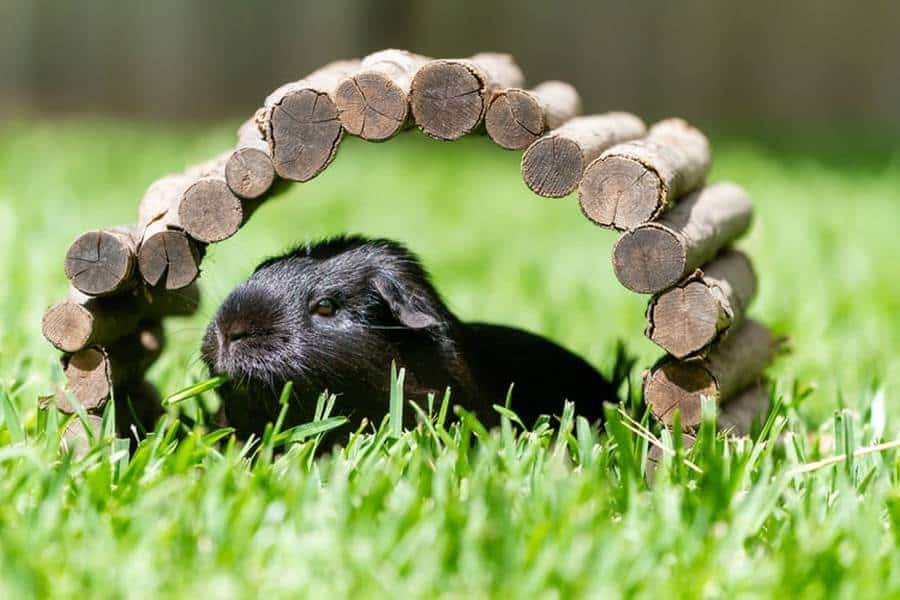
4. Bedding To Keep A Clean Guinea Pig Cage
A very important part of a guinea pig cage is the bedding. Bedding is what traps urine and catches poop pellets. It is critical to clean the bedding frequently so that your guinea pigs aren’t breathing in urine smells.
They have sensitive respiratory systems so prolonged exposure to dirty cages can be troublesome for their health. Moreover, regular cleaning ensures that your living space doesn’t smell like guinea pigs too much.
The most popular type of bedding is paper bedding. This is safe for a guinea pig to ingest if they decide to chew it and tends to be the most absorbent. Some people choose to use wood bedding in their guinea pig cages.
However, guinea pigs are sensitive to certain types of wood like pine, so wood isn’t necessarily a good choice. It also isn’t as comfortable! Paper bedding is the way to go!
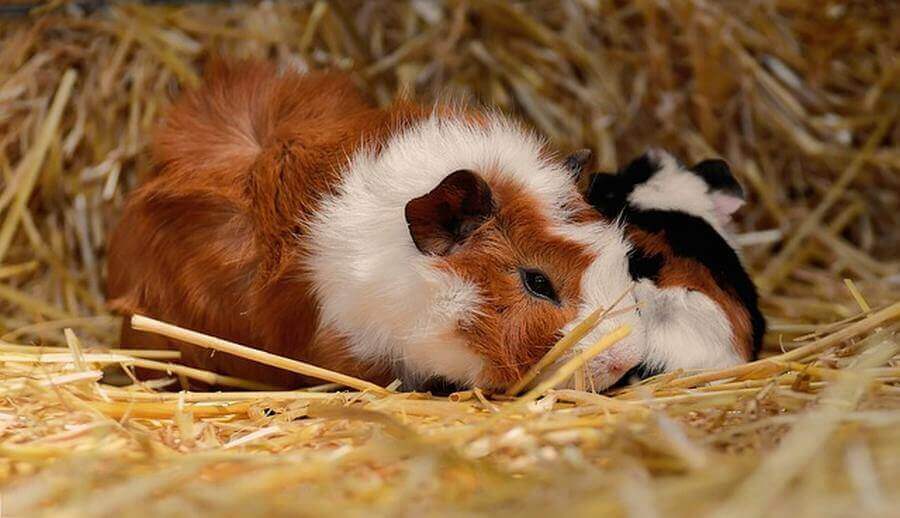
5. Chew Toys For Healthy Guinea Pig’s Teeth
There are many different chew toys available for rodents. These aren’t the same as chew toys that are made for dogs! Rodent chew toys are made of wood, twine, or hay and encourage chewing. A guinea pig’s teeth are constantly growing so it is necessary to have things around for them to chew on.
This helps grinds down their teeth so they do not become overgrown. These chew toys come in a variety of fun shapes and are an excellent way to keep your piggie from getting bored.
Supplemental Items For Guinea Pig Cages
Keep A Rack, Container, Or Bag For Hay In Your Guinea Pig Cage
Just as guinea pigs (and other rodents) need access to chew toys, they also need continuous access to hay. Hay serves as a means to help grind down their teeth but it also serves another important purpose. It has fiber that is essential to their diets.
While hay is a basic cage necessity, how it is stored in the cage is where it also becomes a supplemental item.
Hay can be stored in a number of ways. It can be placed directly on the cage floor but sometimes it can become quite messy. To help keep it contained, the use of a hayrack, container, or bag may be useful. These items snap on the side of the cage bars and keep hay organized and the cage floor less cluttered.
Plush Dog Toys For Your Guinea Pig Cage
Plush dog toys are a charming way to add some fun to your guinea pig’s cage. They come in so many different styles and shapes! They are a soft item that provides additional comfort for your guinea pigs. When picking out a plush dog toy always make sure there’s no squeaker in the middle.
This could scare a guinea pig if they accidentally make it squeak.
Some guinea pigs love plush dog toys. They may take naps on them or drag them around their cage to their favorite place. If you find that your piggie loves these types of toys, be sure to get plenty of them!
You can also swap them out so the cage isn’t getting overly cluttered. They are usually machine washable so cleaning them is easy as well!
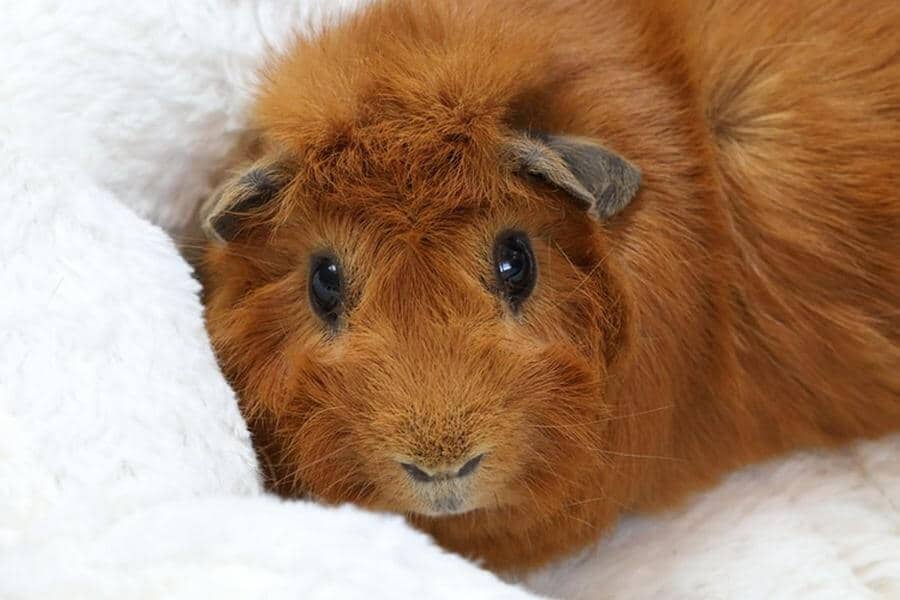
Toilet Tissue Or Paper Towel Tubes Make Fun Chewing Items
Old toilet tissue or paper towel tubes are always a fun supplemental item for a piggie cage. You can stuff them full of hay or vitamin c chews to add even more fun to them. Guinea pigs love these tubes because they not only encourage chewing but the cardboard is safe for them.
They will have a blast chewing them up and finding whatever surprises you put inside of them!
Tunnels For Your Guinea Pig Cage
Guinea pigs are known for loving tunnels. They love running through them as well as napping inside of them! You can buy a cat tunnel that has crinkle material on it. Guinea pigs love the sound of crinkle tunnels as they run through them. This is probably because they think they are getting a snack!
Even though the crinkle cat tunnels are a popular choice for guinea pigs, anything can be made into a tunnel for piggies! Old cardboard boxes can have holes cut into them to create makeshift tunnels. Guinea pigs won’t care either way. They will enjoy whatever type of tunnel you may choose for them!
Guinea Pigs Like Hide-Away Curtains In Their Cage
Plastic igloos or grass huts are excellent hide-away choices but so are hide-away curtains! This supplemental cage item is popular for piggies who have C&C grid cages. C&C grid cages are customizable cages made of wire grids that can be interlocked together in a variety of ways.
To make a hide-away curtain, cut up an old towel or fabric into strips and tie them to the C&C cage wire grid. The grid can then be affixed to the cage so that the tied-on strips hang down. Piggies love running through these strips as well as hiding behind them!
While a guinea pig cage should have basic things like water bottles and food bowls, there are other fun supplemental items too! The important thing is that a guinea pig’s cage is comfortable and provides your piggy (or piggies!) with plenty to explore and do.
No matter the size of the cage, these items can be placed to ensure your piggy has everything that it needs.
Depending on the size of the cage will determine just how many items you should be putting in there. You don’t want your guinea pig to have too small of a cage because then they aren’t getting the proper exercise they need. The proper cage size will also keep your guinea pig engaged which, as expressed, is a key element to enriching their life.
On average, a guinea pig cage should be around 42in x 24in (or 106cm x 61cm) in size. This can fit 1 or 2 guinea pigs. Ideally, you should have 2 piggies, as they are social animals. However, if you only have one try to have a bigger cage anyways. C&C cages are an affordable way to build a larger environment and generally provide more space than pet store cages.
What Do You Put In The Bottom Of A Guinea Pig Cage?
Paper bedding is the best thing to put at the bottom of a guinea pig cage. It is absorbent and helps with the odor of urine. Of course, this is made possible by proper cage cleaning. You should be spot cleaning dirty areas of the cage daily and give the cage a full swap out of bedding once a week but no more than a week and a half.
However, the paper bedding isn’t the only thing to put at the bottom of the cage. Puppy pads can be used under the bedding to add another absorbent layer.
If you have a regular cage that has a plastic bottom then that’s all you need to place at the bottom. However, if you have a C&C cage you will need to have some sort of bottom. This is usually done by using coroplast which is a thick corrugated plastic that folds up to fit at the bottom of the wire grids.
Another option is to use a canvas liner that can be fastened to the wire grids. Either is acceptable but the coroplast is the most popular.
With C&C cage grids, people generally use fleece liners on the bottom of their canvas or coroplast bottoms. These lines can be bought pre-made and are a great investment for those who do not want to deal with paper bedding.
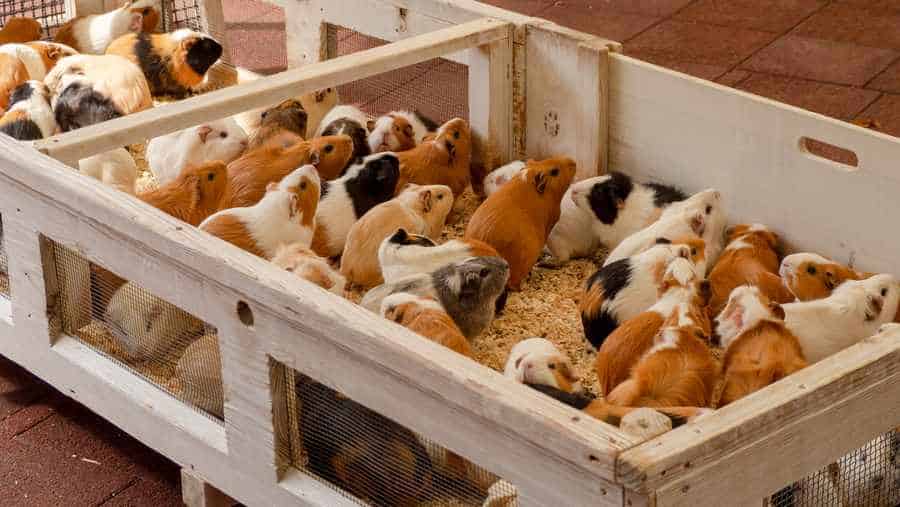
Another popular choice for fleece liners is to buy print fleece from a fabric store (anti-pill fleece as it wicks away moisture better). This can become costly but once again, if it works for your piggy (or piggies!) then it’s worth the money.
Fleece bought from a fabric store needs to be prepared so that urine can easily pass through it. This is why anti-pilling fleece is better. Once the anti-pilling fleece has been washed a few times in cold water with free and clear detergent and thoroughly dried, it is ready to be used in a guinea pig’s cage.
It is important to note that there should be an absorbent layer under the fleece to collect urine. This is where puppy pads come in handy. They are easy to clean up as well!
Fleece and paper bedding both have their pros and their cons. If you have time to wash fleece and maintain the fleece by regularly washing it and ensuring there are puppy pads under it, fleece could be the answer for you.
If you would rather simply use paper bedding along with puppy pads and simply toss out the bedding, paper bedding could be for you. Ultimately, it all comes down to what works best for you and keeps your guinea pig happy and healthy.
How Often Should You Take A Guinea Pig Out Its Cage?
Owning a guinea pig requires much more than simply allowing them to exist in their cages. Guinea pigs should come out of their cages once a day if possible for floor time. You could offer them their morning veggies in an enclosed space on the floor. This gives them time to enjoy the outside of their cage as well as get some exercise.
Not all guinea pigs are easy to catch to take out of their cage. Sometimes they can be skittish. This is part of their nature to hide. You should always respect their space in order to bond with them and gain their trust. You can do so by offering them their favorite treat or veggie.
If they allow you to pick them up, then do so. If they don’t, respect that. Over time, if you notice they still won’t let you pick them up, you can use blankets to aid in picking them up. This should be a last resort though and you should always try to bond with them first.
Guinea pigs are animals that make excellent pets. You can really enjoy their company by encouraging their playful sides with proper cage setups. Always provide enough cage space for them to roam around as well as things for them to hide in and play with.
If you do, your guinea pig will love you and live its best life!
More Pages On House Pets
Guinea pigs are one of the world's most unique and adorable rodent pets. These creatures have such large personalities and are often misunderstood. Having a guinea pig as a pet comes with...
Guinea pigs are remarkable rodents that are often kept as pets. While they are misunderstood by some as being boring pets, they are in fact sweet, lovable creatures. They are generally quiet rodents...


